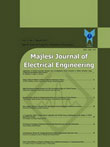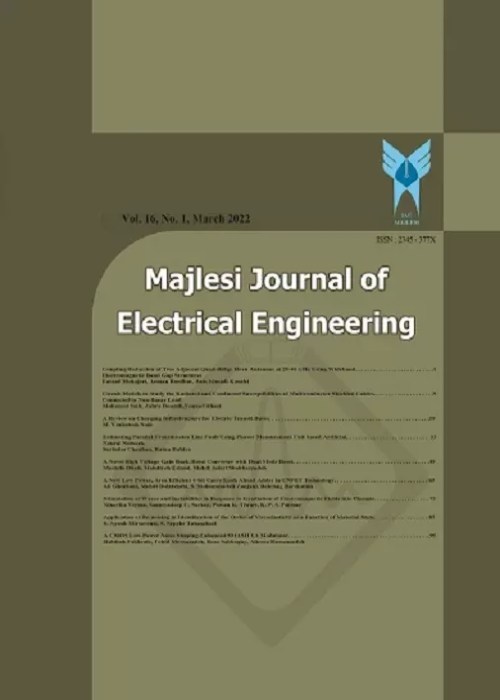فهرست مطالب

Majlesi Journal of Electrical Engineering
Volume:10 Issue: 1, Mar 2016
- تاریخ انتشار: 1395/02/06
- تعداد عناوین: 8
-
Page 1A polynomial trajectory is a time-traveled distance function used to describe trajectory of the robot. Optimal high-degree polynomial trajectories considering initial and the final velocity conditions besides the acceleration constraints are desired. In this paper, a trajectory optimization problem aiming travel maximum distance for a robot that follows an arc based path is formulated. Along the path, the robot requires observing initial and final zero velocity conditions as well as certain acceleration limits. A high-degree polynomial equation along the trajectory is proposed inside of the optimization problem. The closed-form solution of the problem had been obtained analytically. The solution includes the coefficients of the any high-degree trajectory polynomial equation where the coefficients are obtained in closed-form. Simulations several experiments show that the resulting high-degree trajectories satisfy the initial and final zero velocity conditions as well as acceleration constraint.Keywords: Planning, Mobile Robot, Constrained Optimization, Analytic Solution
-
Page 7One of the devices that are widely used in industries in recent years is computer numerical control (CNC) machinery. Many CNC controllers has been designed and employed in CNC machinery during recent years but all of them has some limitations and disadvantages due to their design and used methods. The purpose of this research is designing and modifying a novel multi axis automatic controller (MAAC) for using in CNC machinery which has more advantages compared with used controllers and has an optimized performance. By using MAAC in CNC machinery we can achieve more machining speed and repeatability in a shorter time in implementation of industrial process.Keywords: CNC Controller, Machining Speed, Operation Time
-
Page 13In restructured electricity markets, the consumers have various procurement strategies to supply their electricity demand from alternative resources such as self-generating facility, bilateral contracts and pool market purchase. This paper proposes a hybrid approach based on binary imperialist competitive algorithm (BICA) and binary particle swarm optimization (BPSO) to find optimal procurement for large consumers with multiple procurement options. The solution of these problems provides adequate information to obtain an electricity procurement problem for large consumers. Also, the results are compared with ICA and PSO methods. Test results show that the proposed hybrid approach is more effective and has higher capability in finding the optimum solutions in comparison with ICA and PSO methods. A case study is used to illustrate the efficiency of the proposed hybrid approach.Keywords: procurement strategy, Large Consumers, Binary imperialist competitive algorithm (BICA), binary particle swarm optimization (BPSO)
-
Page 23The record of student attendance in most universities is done by calling the roll. This kind of calling is not only waste of class time, but also cannot be a true reflection of the real student attendance. The use of an alternative new system is becoming a mandate to manage students and staff attendance. The Radio Frequency Identification is the technology which will be applied as infrastructure in the indoor environment to enable the university management to take the advantages of its own and to enhance the university's monitoring system, taking into account factors such as reliability, time saving, and easy control. This paper automates the design and implementation of a students/employees/lecturers attendance management system in terms of hardware and software in Al-Nahrain University in Baghdad. This system is named Al-Nahrain University Student Employee Attendance Management System (AUSEAMS). This system initially uses an RFID tagging system coupled with a web based database system to obtain complete system functionality where the information is manipulated in real time. Preliminary simulation results confirm the validity of the proposed system.Keywords: RFID Technology, Attendance System, Tags, Readers, Classrooms
-
Page 35Many industrial processes are Multi-Input Multi-Output (MIMO) that has more than one controlled variable. Therefore, without considering the impact of these factors it is not possible to achieve the desired performance. In this paper, two methods, adaptive controller and self-tuning fuzzy PID controller is used to control the quadruple-tank process. Although the both presented methods are able to eliminate disturbance effect and reach steady-state with acceptable performance, the fuzzy controller is preferred to the adaptive controller due to the lower computational effort. Moreover, the fuzzy controller does not need the transfer function of the system, while it has a simple design procedure and simple arithmetic. Superiority of the proposed method is automatic adjustment of multivariable fuzzy controller parameters to achieve desirable performance.Keywords: Self, tuning fuzzy controller, adaptive controller, multi, variable systems, recursive least square, relative gain arrays
-
Page 43Designing nonlinear optimal controllers such as Minimum Variance Controller (MVC) has many difficulties. Main difficulties are 1) in order to design controller; the explicit relations between outputs and inputs must be executable. This relation is defined implicitly in the nonlinear models; 2) learning controller is high dimensional-multimodal optimization task and search space can be extremely rugged and has many local minima. For overcoming these disadvantages, in this paper, the model free optimal controller scheme is utilized. In model free controller, as the system model is not available, the gradient of the cost function cannot be executed. Instead, in this paper, a relation between gradient of the controller with gradient of the system model is derived by inverse lemma. The controller structure is selected to be neural network. Then, the gradient based PSO (GPSO) is proposed to learning the controller. GPSO has both advantages of global searching and convergence properties. The application of the methodology to the empirical the CSTR model indicates that this approach gives very credible estimates of the controller. The simulation results indicate that the proposed method can be more accurate than existing methods.Keywords: Nonlinear optimal controller, Neural networks MVC learning, Gradient based PSO, CSTR benchmark system
-
Page 51Because of the great benefits of distributed generation (DG) resources, such as inexhaustible and nonpolluting, they have more influence in the power industry, especially in distributed networks. DGs such as fuel cells, solar cells, wind turbines and micro gas turbines, etc. are going to be installed in demand side of power systems. Such DGs can reduce power losses if they are placed appropriately in the distribution networks. In this paper presents ant colony algorithm for optimal placement and sizing of DGs in radial distribution networks for the purpose of cost minimization. The objective function includes the cost of power losses and installed DGs cost. By applying the proposed method, the economic cost and power losses are reduced to a considerable degree while enhancing the voltage profile. Algorithm to optimize the objective function written in Matlab and simulation results are investigated on a test case from a section of Tehran distribution network consisting of 13 buses.Keywords: Distributed generators, Ant colony algorithm, Cost minimization, Loss reduction, Voltage profile improvement
-
Page 57This paper proposes a unified neural network controller in development of series active power filter. Three major power quality problems considered for this work are harmonics, sags, and interruptions, and dealing with all of them really needs effective unified algorithm which could adapt with variation of signals. Therefore, Levenberg-Marquardt (L-M) back propagation algorithm is introduced in this controller which helps the proposed controller to work properly with dynamic responses with appropriate achievement of convergence. Simulation results clearly show high performance of the proposed controller with series APF system. Its ability of adaptive estimating enhances the response time of the system to only one cycle. It performs well under various testing conditions with significant reduction of harmonics, correction of sags, and fast response to interruptions.Keywords: Sags, Harmonics, Interruptions, Neural Network, Active Power Filter, Power Quality


